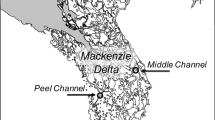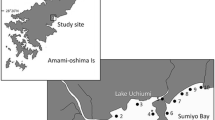Abstract
The burbot, Lota lota, is a widely distributed gadid of the northern circumpolar regions of North America and Eurasia. Despite its near ubiquity over much of its range, relatively little is known about its biology during the first year of life.
Burbot sac-fry of 3 mm total length, hatched under the ice in early May in Shebandowan Lake. Their first foods following atrophy of the yolk-sac were copepods and cladocerans which they captured pelagically. At first the fry swam in small schools, high in the water column of the near-shore littoral, and fed during the daytime. Upon reaching 30 mm in total length, the burbot fingerlings became solitary and benthic, and fed primarily at night, almost exclusively on the amphipod, Hyalella azteca. Amphipods constituted about 75 per cent by number of all the food consumed by burbot fingerlings in their first year of life. Growth was rapid from May to the end of July, tapered off during August to October, and effectively stopped by November at freeze-up. The principal habitat of burbot fingerlings during the benthic stages of their life was the near-shore littoral, in depths ranging from 0.5 m to 4.0 m. There, they were sheltered by boulder shoals, sunken trees or other debris, or beds of quillworts (Isoetes sp.). The principal ichthyofauna that cohabited with the burbot included the sculpin (Cottus cognatus), the smallmouth bass (Micropterus dolomieui), two etheostomatines (Etheostoma nigrum) and (E. exile) and the yellow perch (Percaflavescens). Burbot fingerlings were subjected to low levels of prédation from the nocturnal foraging of walleyes (Stizostedion vitreum).
Access this chapter
Tax calculation will be finalised at checkout
Purchases are for personal use only
Preview
Unable to display preview. Download preview PDF.
Similar content being viewed by others
References
Bailey, M. M., 1972. Age, growth, reproduction, and food of the burbot, Lota lota (Linnaeus), in Southwestern Lake Superior. Trans, am. Fish. Soc. 101: 667–674.
Beeton, A. M., 1956. Food habits of the burbot (Lota lota lacustris) in the White River, a Michigan trout stream. Copeia No. 1: 58–60.
Boyer, L. F., R. A. Cooper, D. T. Long & T. M. Askew, 1989. Burbot (Lota lota) biogenic sedimentary structures in Lake Superior. J. Great Lakes Res. 15: 174–185.
Clady, M. D., 1976. Distribution and abundance of larval ciscoes, Coregonus artedii, and burbot, Lota lota, in Oneida Lake. J. Great Lakes Res. 2: 185–234.
Clemens, H. P., 1951. The food of the burbot Lota lota maculosa (Le Sueur) in Lake Erie. Trans, am. Fish. Soc. 80: 56–66.
Cucin, D. & D. J. Faber, 1985. Early life studies of lake whitefish (Coregonus clupeaformis), cisco (Coregonus artedii) and yellow perch (Perca flavescens) in Lake Opeongo, Ontario. Ont. Fish. Tech. Rep. Ser. No. 16, 28 p.
Day, A. C, 1983. Biological and population characteristics of and interactions between an unexploited burbot (Lota lota) population and an unexploited lake trout (Salvelinus namaycush) population from Lake Athapapuskow, Manitoba. MS thesis, Univ. of Manitoba, Winnipeg, Man. 177 p.
Elton, C. S., 1923. On the colours of water-mites. Proc. zool. Soc. London (1922): 1231–1239.
Fedoruk, A. N., 1966. Feeding relationship of walleye and smallmouth bass. J. Fish. Res. Bd Can. 23: 941–943.
Forney, J. L., 1972. Biology and management of smallmouth bass in Oneida Lake, New York. New York Fish and Game J. 19: 132–154.
Frost, W. E., 1959. The food of pike, Esox lucius L., in Win-dermere. J. anim. Ecol. 23: 339–360.
Hackney, P. A., 1973. Ecology of the burbot (Lota lota) with special reference to its role in the Lake Opeongo fish community. PhD thesis, Univ. of Toronto. Toronto, ON. 152 p.
Hanson, J. M. & S. U. Qadri, 1980. Morphology and diet of young-of-the-year burbot (Lota lota) in the Ottawa River. Can. Field Nat. 94: 311–314.
Hewson, L. C, 1955. Age, maturity, spawning and food of burbot, Lota lota, in Lake Winnipeg. J. Fish. Res. Bd Can. 12: 930–940.
Hutchinson, G. E., 1959. Concluding remarks. Cold Spring Harbor Symp. Quant. Bio. 22: 415–427.
Ivlev, V. S., 1961. Experimental ecology of the feeding of fishes. Yale Univ. Press, New Haven and London. 302 p.
Karr, J. R., 1963. Age, growth, and food habits of johnny, slenderhead and blacksided darters of Boone County, Iowa. Proc. Iowa. Acad. Sci. 70: 228–236.
Kerr, S. R., 1974. Structural analysis of aquatic communities. Proc. 1st. Int. Cong. Ecol: 69-74.
Kerr, S. R. & R. A. Ryder, 1977. Niche theory and percid community structure. J. Fish. Res. Bd Can. 34: 1952–1958.
Kirillov, A. F., 1988. Burbot, Lota lota, of Vilyuysk Reservoir. Voprosy Ikhtiol. 28: 22–28.
Kuehne, R. A. & R. W. Barbour, 1983. The American darters. Univ. Press of Kentucky, Lexington, Kentucky.
Lagler, K. F., 1956. Freshwater Fishery Biology. W. C. Brown Co., Dubuque, Iowa.
Larkin, P. A., 1956. Interspecific competition and population control in freshwater fish. J. Fish. Res. Bd Can. 13: 327–342.
Larkin, P. A., 1963. Interspecific competition and exploitation. J. Fish. Res. Bd Can. 20: 647–678.
Lawler, G. H., 1963. The biology and taxonomy of the burbot, Lota lota, in Heming Lake, Manitoba. J. Fish. Res. Bd Can. 20: 417–433.
Lawler, G. H., 1965. The food of the pike, Esox lucius, in Heming Lake, Manitoba. J. Fish. Res. Bd Can. 22: 1357–1377.
Magnin, E. & C. Fradette, 1977. Croissance et regime alimentaire de la lotte Lota lota (Linnaeus 1758) dans divers lacs et rivieres du Quebec. Naturaliste can. 104: 207–222.
Markun, M. L, 1936. On the burbot (Lota lota) of the river Kama. Bull. Inst. Biol. Res., Works of the Kama Biol. Sta. No. 1: 236–237.
Martin, N. V., 1970. Long-term effects of diet on the biology of the lake trout and the fishery in Lake Opeongo, Ontario. J. Fish. Res. Bd Can. 27: 125–146.
McCrimmon, H. R. & O. E. Devitt, 1954. Winter studies on the burbot (Lota lota lacustris) of Lake Simcoe. Can. Fish. Cult. 16: 34–41.
McNaught, D. C, 1957. Comparative food habits of brook trout (Salvelinus fontinalis) and burbot (Lota lota) in the Fox River, Michigan. MS thesis, Univ. of Michigan, Ann Arbor, MI. 25 pp.
McPhail, J. D. & C. C. Lindsey, 1970. Freshwater fishes of northwestern Canada and Alaska. Fish. Res. Bd Can., Bull. 173. 381 pp.
Merritt, R. W. & K. W. Cummins, 1978. An introduction to the aquatic insects of North America. Kendall/Hunt Publ. Co., Dubuque, Iowa. 441 pp.
Meshkov, M. M., 1967. Developmental stages of the burbot [Lota lota (L.)]. Problems of Ichthyology and Hydrobiology in Inland Reservoirs. 62: 181–194.
Needham, J. G. & P. R. Needham, 1951. A guide to the study of fresh-water biology. Comstock Publ. Co., Inc., Ithaca, New York. 89 pp.
Nelichik, V. A., 1973. The burbot [Lota lota (L.)] of the Upper Tuloma Reservoir. Voprosy Ikhtiol. 13: 834–839.
Pennak, R. W., 1978. Fresh-water invertebrates of the United States (Second Edition). John Wiley & Sons, Toronto. 803 pp.
Pivnicka, K., 1970. Morphological variation in the burbot (Lota lota) and recognition of the subspecies: a review. J. Fish. Res. Bd Can. 27: 1757–1765.
Robins, C. R. & E. E. Deubler Jr., 1955. The life history and systematic status of the burbot, Lota lota lacustris (Wal-baum), in the Susquehanna River system. Dept. of Cons., Cornell Univ., Albany, New York. 49 pp.
Ryder, R. A., 1977. Effects of ambient light variations on behaviour of yearling, subadult, and adult walleyes (Stizostedion vitreum vitreum). J. Fish. Res. Bd Can. 34: 1481–1491.
Ryder, R. A. & S. R. Kerr, 1978. The adult walleye in the percid community — a niche definition based on feeding behaviour and food specificity. In R. L. Kendall (ed.), Selected coolwater fishes of North America. Am. Fish. Soc. Spec. Pub. No. 11: 39–51.
Ryder, R. A. & S. R. Kerr, 1990. Harmonic communities in aquatic ecosystems: a management perspective. In W. L. T. van Densen, B. Steinmetz and R. H. Hughes (eds), Management of freshwater fisheries. Proc. Symp. EIFAC, Göteborg, Sweden. Pudoc, Wageningen: 594–623.
Schoener, T. W., 1974. Resource partitioning in ecological communities. Science 185: 27–39.
Scott, W. B. & E. J. Crossman, 1973. Freshwater fishes of Canada. Fish. Res. Bd Can., Bull. 184. 966 pp.
Snyder, D. E., 1979. Burbot — larval evidence for more than one North American species. Proc. 3rd Symp. on Larval Fishes, Bowling Green, Kentucky: 204–219.
Swenson, W. A. & L. L. Smith Jr., 1976. Influence of food competition, predation, and cannibalism on walleye (Stizostedion vitreum vitreum) and s auger (S. canadense) populations in Lake of the Woods, Minnesota. J. Fish. Res. Bd Can. 33: 1946–1954.
Toner, E. D. & G. H. Lawler, 1969. Synopsis of biological data on the pike, Esox lucius Linnaeus 1758. FAO Fish. Syn. No. 30, rev. 1, Rome. 39 pp.
Turner, C. L., 1921. Food of the common Ohio darters. Ohio J. of Science 22: 41–62.
Welch, H. E., 1967. Energy flow through the major macroscopic components of an aquatic ecosystem. PhD Dissertation, Univ. Georgia, Athens, Georgia.
Author information
Authors and Affiliations
Editor information
Rights and permissions
Copyright information
© 1992 Springer Science+Business Media Dordrecht
About this paper
Cite this paper
Ryder, R.A., Pesendorfer, J. (1992). Food, growth, habitat, and community interactions of young-of-the-year burbot, Lota lota L., in a Precambrian Shield lake. In: Ilmavirta, V., Jones, R.I. (eds) The Dynamics and Use of Lacustrine Ecosystems. Developments in Hydrobiology, vol 79. Springer, Dordrecht. https://doi.org/10.1007/978-94-011-2745-5_22
Download citation
DOI: https://doi.org/10.1007/978-94-011-2745-5_22
Publisher Name: Springer, Dordrecht
Print ISBN: 978-94-010-5218-4
Online ISBN: 978-94-011-2745-5
eBook Packages: Springer Book Archive




